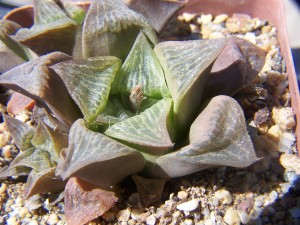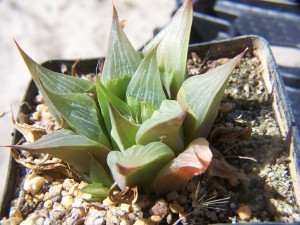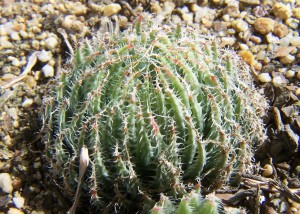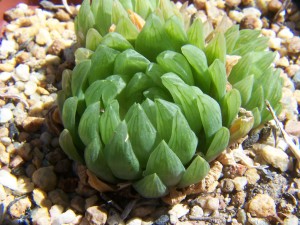Abstract
Classification of plants is often controversial and it is common to suggest that further research and application of technology will resolve problems. This paper overviews six publications in peer reviewed botanical journals with respect to the classification of Asphodelaceae: Alooideae and particularly Haworthia. It demonstrates that there is a gulf between the results produced by researchers using sophisticated technology and the practical, ordinary observations of the layman. This may be because researchers are not familiarizing themselves with grassroots information and observation, which is observation of the plants in the field, in cultivation, in the herbarium and in the literature. Their results may thus be contrary to the experience of the layman who may in fact be better informed.
Introduction
The classification of Haworthia has quite a turbulent history. This is generally attributable to the fact that it is a difficult genus in terms of the vegetative plasticity of individual plants and the many populations that have a shared history in time and space in geologically and geomorphologically diverse environments. Confounding these environmental variables are the concepts and techniques of the taxonomists that have been involved in naming plants within the genus. The popularity of Haworthia with succulent plant hobbyists has meant that many of these workers have by-and-large not been professional or qualified taxonomists. Therefore it is of considerable interest to note some significant publications in respect of the broader subject viz. the Alooideae, written by professionals and recently published in peer-reviewed botanical journals. This could confirm whether or not the problem lies with the difficulty of the subject and/or skills of the respective researchers or taxonomists.
Discussion
The first publication of six that I review here is by Vosa and Bennet (1990) with respect to Gasteria. The general conclusion was reached that the cytological differences are minimal and that there may be only one species. In this work the nomenclature and terminology is inconsistent and the data are also presented in an inconsistent way. Furthermore, the material used is not representative of the genus (Bayer, 2000). The paper very effectively demonstrates the need for a sound organization (classification) of materials before work commences. There was no revision in place prior to the work by Vosa and Bennet and there is no statement to say how their material was identified nor by whom. They concluded…”The slight variability is probably not more than that found between the individuals of a normal natural population of a single species”. A correct conclusion would be that the technique employed produced no meaningful understanding of the genus.
A second paper is that by Smith & Van Wyk (1991). This is a cladistic study of the genera in the Alooideae. It is concluded that it is a monophyletic group and suggests that some clarity has been brought to the relationships of the genera. It can, however, be shown that the characters used and the evaluated states of those characters, are erroneous and that the results are consequently misleading. The following is a brief synopsis of the characters and coding (plesiomorphic – derived or advanced character state – 1; and apomorphic – residual or primitive character state – 0) applied by Smith & Van Wyk in their cladistic analysis:
Habit (caulescence) – all genera are scored 1 for this character except the outgroup Kniphofia. According to G.W. Reynolds (1960), Aloe has 130 species in southern Africa of which 30 are acaulescent, 56 caulescent and 47 may be neither of the two states. In my observation of 68 Haworthia species, 58 are acaulescent and 16 are semi-caulescent. Among the former are species like H. pumila and H. herbacea that can form quite distinctive, if prostrate, stems. In H. cymbiformis, which is generally acaulescent, there is the surprising var. ramosa, which is caulescent. It is part of an extensive population north of Wooldridge where the plants are otherwise acaulescent. If the condition is examined in the other genera such as Gasteria and Chortolirion, it seems that the coding used by Smith and van Wyk is simplistic and incorrect.
Leaf arrangement (congestion on stem) – Aloe and Lomatophyllum are scored 1 as each genus is said to have species in which the “leaves are comparatively widely spaced” (others are scored 0). Gasteria rawlinsonii has leaves which must be regarded as “widely spaced”. It can be said that in Haworthia, because the leaves are spirally arranged, it is differences in leaf congestion that result in trifarious, quinquefarious and multifarious leaf arrangements. Thus there is a range of spacing and in fact H. coarctata and H. reinwartdtii can be separated by the difference in the congestion of leaves on the stems of these two species.
Leaf consistency (succulence) – all genera are again scored 1. It is obvious that this is again a simplification. Even Uitewaal (1947) suggested that leaf consistency could provide a basis for separation of Haworthia into the three groups he proposed. In the Hexangulares there are species with the added state of having fibrous leaves. The consistency of the leaves of H. graminifolia cannot be equated with that of the case of, say, H. mucronata.
Leaf tuberculation – Astroloba, Gasteria and Haworthia are scored 1, while A. aristata is noted to be tuberculate as a “rare exception” in Aloe. My observation in Haworthia is that 26 species have tuberculate leaves and 42 have smooth non-tuberculate leaves. It is common for H. marginata to have both tuberculate and smooth leaves and this is less rarely the case in other species of the Robustipedunculares. In H. limifolia, the var. gigantea has tubercled leaves, the vars. ubomboensis and glaucophylla have entirely smooth leaves, while vars. limifolia and arcana are characterized by transverse ridges or semiconfluent tubercles. The state in A. aristata adds a complication as the “tubercles’ may be homologous or comparable with the surface spination, translucent or simple white markings on the leaves of many species in many of the genera.
Outline of leaf cross-section – all genera are again scored 1, as of course, against the outgroup (Kniphofia). Reynolds (1950) states that in A. cooperi, “leaves are keeled resembling a “V” in cross-section, and mentions this for A. variegata, A. sladeniana and A. dinteri too. It is quite misleading to suggest that leaf outline in the Alooid genera is crescentiform/cymbiform and synapomorphic for all the taxa in the Alooideae. Note the confusion of the terms outline as described by “cymbiform” and cross-section. How can one consider the shape of the leaves (cross-section or outline) of, say H. viscosa as even similar to the leaves of for e.g. H. cymbiformis var. obtusa? In total the two authors code sixteen such characters and it is beyond the scope of this paper to tediously discuss each of them. The question of the character “floral symmetry” does, however, perhaps deserve attention and that will be discussed in the fourth paper.
The third paper is by Smith et al. (1995). It concerns the reversal of the very curious re-instatement of the genera Aloinella (as Lemeea) and Guillauminia affected by Heath (1993, 1994). Heath’s argumentation was weak indeed, but the counter argument by Smith et al. is equally poor. The balance is only in favour of Smith et al. because there are no substantial criteria that suggest that different genera are involved in the first place. (Bayer, 2003a). My complaint now is that the papers by both Heath and Smith et al. fiddle with the classification and nomenclature, without adding one iota of information to the subject. The facts are:
A. haworthioides and A. albiflora do in fact have characters which make them most unusual in the genus Aloe. There is no Aloe remotely like A. haworthioides that has the extraordinarily protruding flattened filaments. These form a reddish tube nearly as large and conspicuous as that of the perianth itself, which is almost hidden by the large floral bract. In the case of A. albiflora, the florets are widely campanulate and sparsely arranged on the slender peduncle. Reynolds placed 12 species together in his Group 1 of Madagascan Aloes and stated most plainly that they were not closely allied. Now Heath has ignored three of those 12 species and made two groups out of the disparate remnant. This is the problem that Smith et al. should have addressed. The curious thing about this is that there appears to be a similarity between A. bellatula and A. perrieri (ignored and abandoned in Aloe by Heath, and not even considered by Smith et al.), which in terms of variability could be extended to A. albiflora and perhaps further to A. parvula. There is no such similarity between A. haworthioides, and A. bouteaui. A. descoingsii and A. calcairophylla do seem to have unique florets. There is nothing odd about the florets in A. rauhii or A. bakeri that could necessarily separate them from, A. versicolor and A. parallelifolia.
The fourth paper concerns the genus Poellnitzia and its transfer to Astroloba by Manning and Smith (2000). Again the argument is weak, particularly in respect of the statement… “accords completely with the genus in its tubular actinomorphic flower with included stamens”. The flowers in neither genus are actinomorphic and it was, and is, the elongation of the tube as well as the connivent petal tips that precluded anyone from suggesting that Poellnitzia was an Astroloba in the first instance (Bayer, 2003a)
The next paper is by Smith et al. (2000) and it concerns nectar sugars particularly with respect to Haworthia. Smith et al. cite my paper (Bayer, 1972) where the main message was that the genera in this group would never be resolved while the main elements within the genus Haworthia were not recognized to be discrete. Uitewaal’s (1947) attempt to subdivide Haworthia was a much labored effort. He was clearly a victim of his time in trying to establish a hierarchical classification and it is a distortion of the facts to say that he divided Haworthia into two main groups. There is no difficulty whatsoever in recognizing that he identified and recognized THREE, and not the two that Smith et al. claim. Uitewaal recognized two groups; Triangulares and Hexangulares based primarily on the shape of the flower base, but he then split Hexangulares into Robustipedunculatae and Gracilipedunculatae, primarily on the robustness of the peduncle. As an interested observer of Haworthia, I added the additional facts from geographical distributions and capsules to recognize Uitewaal’s groups as three sub-genera. It is interesting that no significance seems to be attached by Smith et al. to the fact that the nectar sugars in Astroloba are sucrose dominated whereas in Poellnitzia the nectar sucrose is less than 5%. These authors also find that… “The correlation of nectar in Astroloba and members of the H. subg. Robustipedunculares with the sucrose-rich Hexangulares type is surprising. Because of floral and other morphological features they expected that the sugar composition belonging to these two units would be nearer to the sucrose-low Aloe type nectar…”. This seems to be an odd statement when there is very little to support their expectation in the sense of the classification history of the groups and the statements concerning the two genera (Bayer, 1972).
The paper concerning a DNA study by Treutlein et al. (2003a) is also a very curious one and the result is summarized in this statement… “The current taxonomic system does not reflect the phylogenetic affinities and relationships among the succulent genera Aloe, Chortolirion, Gasteria, Haworthia and Poellnitzia.” That is quite obvious simply from the papers noted to this point and, had this been considered at the start of the study, surely this would have been the question to be addressed. The selection of material I take to be somewhat irresponsible given the past history of classification of the group and the literature. The inclusion of unknown hybrids such as H. X ryderiana, H. X kewensis, and H. X icosiphylla can tell us nothing. Likewise the failure to deposit vouchers in a recognised herbarium is problematic. Ignorance of the taxonomic position of H. geraldii is similarly curious and had the authors (and reviewers) known, as well they could have, that this taxon is simply a local variant in the H. retusa/turgida complex, and they would have been alerted to the anomalous and also startling result which finds them placing it in a different sub-genus. It can be noted that B.J.M. Zonneveld’s (geneticist, Leiden Univ. – pers.comm.) observations on total mass of nuclear DNA suggests that plants in cultivation in Europe are polyploids while field collected samples from South Africa fall in the normal diploid range for H. turgida or H. retusa as opposed to a higher value for species of the Hexangulares.
The authors repeat the mistake of stating Uitewaal’s contention that there were two main groups in Haworthia and mistakenly state…”two main units (Triangulares and Hexangulares), the former including the subgenus Haworthia and Subgenus Robustipedunculares.” Uitewaal divided the group Hexangulares into Gracilipedunculatae and Robustipedunculatae, not the group Triangulares. The way this has been repeated in the closing paragraph of Uitewaal’s paper has confounded Treutlein et al., who go on to say, “This division (into two groups) is strongly supported by…” their results. This is not true. Treutlein et al. have no representatives from the Robustipedunculares in their analysis apart from the DNA (cytoplasmic) in the hybrid XAstroworthia. It is thus not surprising that this “species” comes out in the “heterogenous group” that includes Aloe aristata, Gasteria, Poellnitzia, Astroloba and H. retusa (“geraldii”, with the position here of the latter extremely dubious if not totally erroneous). The suggestion that Haworthia could be split into two genera as a result of this study is misplaced because of the omission of members of the Robustipedunculares and ignorance of the actual situation reflected in the history of the groups where there are three groups that have to be considered.
Treutlein et al. are also the authors of another paper (2003b) and there three observations are made which I must contest.
1. …”An exception in the current classification was found with the sister species H. geraldiiand H. gracilis var. tenera: genetically they belong to group ll, whereas morphologically they show affinities to the subgenus Haworthia (represented by group 1).”
2. … “H. geraldii and H. gracilis var. tenera are sister species according to rbcL (fig.1A) and matK (fig.1B). Contrary to their previous morphological classification (Bayer, 1999), they are clearly grouped in Haworthia subgenus Hexangulares by both molecular markers.”
3. … ” the taxonomy of the genus Haworthia must be revisited. More species of both groups need to be examined to determine their phylogenetic relationships before taxonomic consequences should be drawn.
Where Treutlein et al., did not cite my Haworthia Revisited (Bayer, 1999) in their first paper, they do in this second one. It is difficult to know why, when they have not grasped that it is not a “morphological classification” as they claim, and thus could not have referred to it at all. My revision is probably unusual in that such pains are taken to explain a species concept and to state specifically that the geographical component is the over-riding consideration in the classification although it is also fortuitously a morphological one.
The question of the subgeneric relationships of H. geraldii and H. gracilis var. tenera is a fundamental issue. If either of these had been considered and reviewed as the taxa that the literature suggests (Bayer, 1974, Bayer 1999, Bayer, 2002a), it would have been quite evident that the conclusion Treutlein et al. reach with such facility is impossible. Certainly the taxon “geraldii” has been discussed many times. Further discussion gives credibility to the recognition of local variants as full species that is wholly misplaced. In the case of H. gracilis var. tenera, the writers can be excused for overlooking the discussion of this taxon in my book Haworthia Update (Bayer, 2002a) or in “Ecotypes in Haworthia” (Bayer, 2003b). In the latter paper I explain why the species “gracilis” and all its varieties are transferred to H. cooperi. This was effected in Haworthiad (Bayer, 2002b). It is obvious to any reader that the two taxa “tenera” and “gracilis” cannot be excised from the subgenus Haworthia by any stratagem at all, but this should have been apparent regardless of my two papers. That the term “sister species” (for ‘geraldii’ and ‘tenera’) is used, wholly disregards anything that I have written in respect of a “species” concept for Haworthia. No matter how the subgenus Haworthia is manipulated these two taxa are elements in quite different sub-domains of two species and in the subgenus Haworthia, not Hexangulares as Treutlein et al. show in their phylograms. It is unfortuante that researchers can be so unfamiliar with the classification of the elements they work with. Lee (2004) argues that such molecular diagnoses need to be based on an appropriate taxonomic framework in turn based on all appropriate biological information. Otherwise they are premature and likely to cause problems rather than solve them.
The observation that the classification of Haworthia should be revisited is quite unnecessary in the light of what I stated in my revision (1999). These authors have not understood what the basis of the revision was. It is based on a conceptualization of species as systems and recognition of three sub-genera. Thus where Treutlein et al. (2003b) state that…”The present study unequivocally shows that molecular evidence conflicts with the current treatment of Haworthia as a single genus” is therefore misleading. Similarly the statement that their data set supports a dichotomy of Haworthia is only true because of the omission of representatives of one of the sub-genera. Their failure to have familiarized themselves with the literature that they cite is evident.
One has to recognize that the classification in place is the product of a very long history and is reasonably sound and practical. There is also a very extensive herbarium record to support it. It is professional botanists that are not properly familiarizing themselves with the fields they engage. They are not asking logical questions about the relationships of the plants of interest, nor are they selecting authentic or representative samples. Their work in peer-reviewed journals does not pass scrutiny and one is left to consider that the selected peers are not competent to undertake the task expected of them in a proper review process. It should not be necessary for writers in the popular literature to be discredited by results and conclusions derived from frail, poorly conceived and badly planned research projects and publications at the higher academic and intellectual level. Neither should a functional classification system be shaken and threatened by weak research of this kind.






Acknowledgement
I must thank the reviewers of this paper and the editor of this journal for instructive and necessary comment. Steven Hammer similarly provided incisive comment. Dr. Paul Forster has been particularly supportive in assisting me with significant literature as well as his views as a contemporary plant taxonomist and systematist. I must state that I am a parataxonomist (as opposed to a professional botanical systematist). The opinion that I should present a full phylogenetic analysis of my own, rather than direct my criticism of other efforts, should also take cognizance of the fact that all the evidence I can present is that within the extant genera and the three subgenera of Haworthia. It should also be stated that, the nature of variation may frequently defy any conventional Linnanean or Hennigian paradigms (Brummitt, 2002).
Literature Cited
Bayer, M.B. 1972. Re-instatement of the genera Astroloba and Poellnitzia (Liliaceae- Aloineae). Natl.Cact.Succ.J. 27:77-79.
Bayer, M.B. 1974. Haworthia Duv.: Section Retusae fide Scott – additional comment. Aloe 12:89-98.
Bayer, M.B. 1999. Haworthia Revisited. Umdaus Press, Pretoria.
Bayer, M.B. 2000. Observations – cytology as a character source in Gasteria. In Thoughts on Haworthia :96-99. Addendum 9. (ISBN No. 0-620-25323-1) Spiderwalk Services, Cape Town.
Bayer, M.B. 2002a. The case of Haworthia incurvula. Haworthia Update 1:25-33. Umdaus Press, Pretoria. (Revised from Aloe 36:34, 1969).
Bayer, M.B. 2002b. New names and combinations in Haworthia. Haworthiad 16:62.
Bayer, M.B. 2003a. Classification with purpose. In Alsterworthia International, special issue No.3.
Bayer, M.B. 2003b. Ecotypes in Haworthia. Aloe 40:10-15. [link]
Brummitt, R.K. 2002. How to chop up a tree. Taxon 51:31-41.
Lee, M.S. 2004. The molecularisation of taxonomy. Invertebrate Systematics 18:1-6.
Manning, J.C. & G.F. Smith. 2000. The genus Poellnitzia included in Astroloba. Bothalia 30:53.
Reynolds, G.W. 1950. The Aloes of South Africa. Johannesburg.
Smith, G.F. & B.E. Van Wyk. 1991. Generic relationships in the Alooideae (Asphodelaceae). Taxon 40:557-581.
Smith, G.F., B.E. Van Wyk, M. Mossmer. & A.Viljoen. 1995. The taxonomy of Aloinella, Guillauminia and Lemeea (Aloaceae). Taxon 44:513-517.
Smith, G.F., B.E. Van Wyk, E.M.E. Steyn & I. Breuer. 2000. Infrageneric classification of Haworthia (Aloaceae): perspectives from nectar sugar analysis. Proceedings of XV1 AETFAT Congress, Belgium. Syst.Geogr.Pl. 71:391-397 (2001).
Treutlein, J., G.F. Smith, B.E. Van Wyk. & W. Wink. 2003a. Phylogenetic relationships in Asphodelaceae (Alooideae) inferred from chloroplast DNA sequences (rbcl, matK) and from genomic finger-printing (ISSR). Taxon 52:193-207.
Treutlein,J., G.F. Smith, B.E. Wyk. & W. Wink. 2003b. Evidence for the polyphyly of Haworthia (Asphodelaceae Subfamily Alooideae; Asparagales) Inferred from nucleotide sequences of rbcL, matK, ITS1 and genomic fingerprinting with ISSR-PCR. Plant. Biol. 5:513-521.
Uitewaal, A.J.A. 1947. A first attempt to subdivide the genus Haworthia, based on floral characters. Desert Plant Life 19:132-136.
Vosa, C. & A. Bennet. 1990. Chromosome studies in the Southern African Flora. Caryologia 43:235-247.
♦
